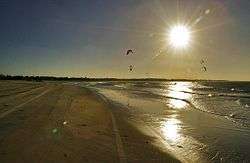São Miguel do Gostoso
São Miguel do Gostoso (previously known as São Miguel de Touros) is a municipality in the state of Rio Grande do Norte in the Northeast region of Brazil. São Miguel do Gostoso was founded on 29 September 1884.
São Miguel do Gostoso | |
|---|---|
Municipality | |
 | |
 Flag | |
| Country | |
| Region | Nordeste |
| State | Rio Grande do Norte |
| Mesoregion | Leste Potiguar |
| Time zone | UTC -3 |
History
On 16 July 1993, the beachfront town of São Miguel split from the municipality of Touros. The new municipality São Miguel do Gostoso held its first elections in 1996 and at this time it was decided that the town would retain its original name of São Miguel de Touros. This decision not to rename the newly created municipality, left the local population disgruntled and as a result a series of requests for a name change were submitted to the head of the municipality. On 19 November 2000, 7 years on from its independence from the municipality of Touros, a local referendum was held and the town's name was changed to São Miguel do Gostoso.
Name origin
According to legend, there was once a man living in the area named Mr. Manoel Gostoso who was known to give shelter to traveling salesmen. Due to Manoel Gostoso's unique sense of humor (he entertained his guests with stories and jokes) and contagious laugh Manoel Gostoso became known in the town as Mr. Gostoso. Thereafter, not only the traveling salesmen but also the locals began to refer to the town as Gostoso. On 29 September 1899, Miguel Félix Martins, in order to fulfill his promise made to the Saint São Miguel, inaugurated the first church of the instated the Saint's image. From that day onward São Miguel has been the Patron Saint of Gostoso. The local population then joined São Miguel to the previous name of Gostoso to create São Miguel do Gostoso.
Access
Before the 1960s, the area required horseback travel due to a lack of roads. In the 1960s the road system BR-101 and RN-221 (Project Pólo Costa das Dunas) were constructed to improve the access between Natal and São Miguel do Gostoso. As a result of these highway constructions São Miguel do Gostoso is easy accessible. In the past the town houses were constructed mainly of "taipa" but are today mostly constructed in bricks and cement.
Tourism
In 1989, the city only had one Pousada (local Bed & Breakfast). Today São Miguel do Gostoso has grown its infrastructure for tourism to approximately 25 Pousadas, a variation of bars and restaurants and two world class kite and wind surf schools are established here. São Miguel do Gostoso with its pristine white, palm tree lined beaches and its perfect wind conditions for kite surfing and windsurfing, attracts a growing number of tourist, professional and amateur kite and wind surfers from all over the world. São Miguel do Gostoso was 26 April 2009 predicted to become the number 1 destinations for future tourism in the state of Rio Grande do Norte, outside the main capital Natal. Recently the municipality, in partnership with EMBRATUR, opened the São Miguel do Gostoso Tourist Office in the middle of the city
General information
- Size: 345.9 km² (equivalent to 0.65% of the state of Rio Grande do Norte)
- Rain: Average 1038.3 mm
- Rainy Season: March to June
- Average Annual Temperature: 26,5 °C
- Average Annual Humidity: 68%
- Population: Approximately 10.000 inhabitants
- Economy: Tourism, Agriculture and Fishing
- Electricity: 220 V
- High speed internet: Yes
- Cell phone coverage: Yes
References
- "Divisão Territorial do Brasil" (in Portuguese). Divisão Territorial do Brasil e Limites Territoriais, Instituto Brasileiro de Geografia e Estatística (IBGE). 1 July 2008. Retrieved 17 December 2009.
- "Estimativas da população para 1º de julho de 2009" (PDF) (in Portuguese). Estimativas de População, Instituto Brasileiro de Geografia e Estatística (IBGE). 14 August 2009. Retrieved 17 December 2009.
- "Ranking decrescente do IDH-M dos municípios do Brasil" (in Portuguese). Atlas do Desenvolvimento Humano, Programa das Nações Unidas para o Desenvolvimento (PNUD). 2000. Retrieved 17 December 2009.
- "Produto Interno Bruto dos Municípios 2002-2005" (PDF) (in Portuguese). Instituto Brasileiro de Geografia e Estatística (IBGE). 19 December 2007. Retrieved 17 December 2009.